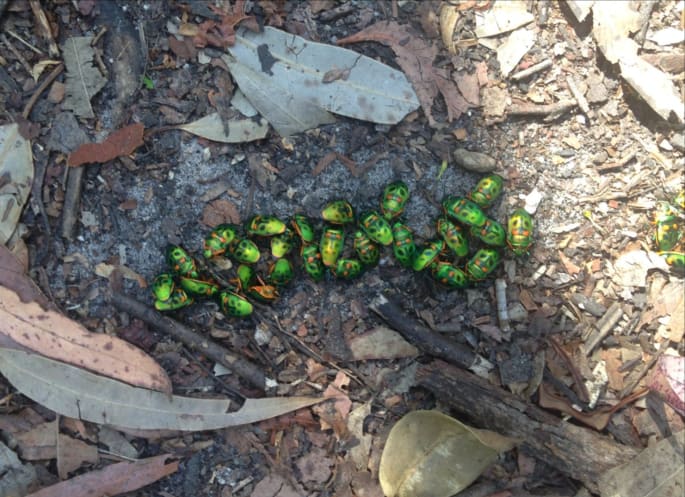Like many people in Helensburgh, I like to take the shortcut through the bushes to get to the railway station. It’s usually because I’ve left the house a bit late. If it’s early in the morning that sometimes means a spider web in the face, but it’s only a short path and I’ve rarely seen much of interest. However, for a few weeks around Christmas, there were clusters of brightly coloured shieldbugs along the tree roots in the middle of the path. More than 100 bugs, in several clusters.
As I’d never seen this before, I took photos and sent them to my colleague Professor Gerry Cassis, who is the expert on this group. He had never seen this behaviour before either. So there you are, in a scruffy and very ordinary bit of Illawarra bush we have something strange going on.
What are they and what are they doing? These are bugs, not beetles. The back-half of them is a single plate-like extension of the thorax covering the wings, not the paired modified wings of a beetle, and they have a sucking straw for a mouth, not a pair of jaws. And they are jewel bugs, family Scutelleridae, notable for that plate-like extension and bright colours. This species is Scutiphora pedicellata, which is common in eastern Australia and has its own Wikipedia page. What is notable about the Wikipedia page is that there is a name, a photo, a summary of distribution and … nothing.

Yes, even for a common, brightly coloured insect like this we know almost nothing.
Some clues are available. Jewel bugs are plant-feeding, and are known to feed on many different plants, including exotic species (see Tasmania link below). But I had a close look at these bugs and none were feeding although they were only found along the roots. I also didn’t see any sex going on (don’t worry, I was very discreet). So it didn’t appear to be a mating swarm. They are stunningly beautiful. This kind of high-contrast colour pattern is an example of aposematism – advertising that you are poisonous.
This appears to be part of the answer – such aggregations can release a cloud of poisonous vapour to deter predators. Looking through the web I found another photo of an aggregation, but of nymphs (larvae), which, of course, don’t have sex organs (see Tasmanian link below) but they do have the poison. So it seems these clusters are for collective defence, not sex. Why in that place at this time? No idea. To find out, I might have collected them all, checked how many males and females, dissected them to see if they were mature, surveyed the bushes … But I was busy and they’ve gone.
My job is largely trying to work out what species are and how to identify them. However, for most of these species, we know nothing or very little about their biology. This kind of value-adding is something that all of you can do.
References
The Scutiphora pedicellata Wikipedia page
Feeding and aggregating in Tasmania: Tasmanian Insect Field Guide






